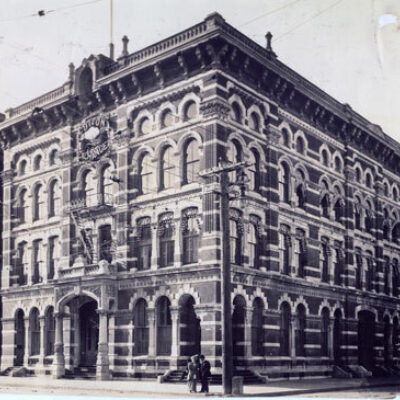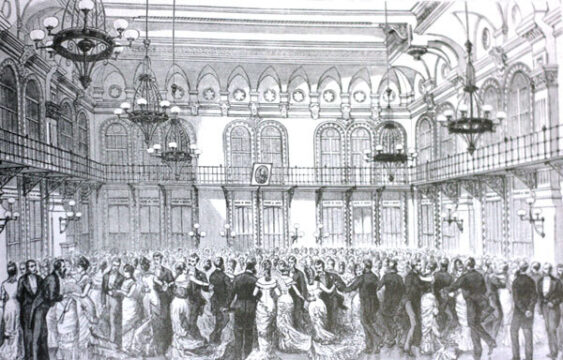Rosenberg Library exhibited historical items related to the Galveston Cotton Exchange, the first cotton exchange established in the state of Texas, during the month of May 2013. The display included the circa 1878 trading bell used to signal the opening and closing of the trade day, as well as historic photographs of the original Cotton Exchange which was touted as “one of the most magnificent buildings in Texas” when it was constructed.

In Galveston’s early days, Thomas F. McKinney and Samuel M. Williams (two of the city’s original developers) were the only cotton buyers in town. The market for cotton quickly grew, however, and by 1858 there were more than twenty brokers on the island. Prior to the Civil War, there was no real need for an organized association of cotton buyers and sellers. Merchants bought cotton directly from growers at a mutually agreeable price and then re-sold it for a profit. There were no grade standards before 1873, nor did cotton futures exist.

After the war, the production of cotton greatly increased; at the same time, the railroad industry was expanding. The interests of cotton buyers and sellers were no longer in line with one another, resulting in numerous court battles. As a result, Galveston cotton merchants formed their own association, as did cotton growers in the island. However, the creation of these separate entities proved an unfavorable solution, and it was recognized by both parties that a joint organization was needed.
In an effort led by Col. W. L. Moody, a special committee was named to draft by-laws for this new association. The primary goals of the group were three-fold: to address pricing disputes between buyers and sellers; to establish fair trade principles; and to collect and disseminate information concerning the crop and market conditions. On May 6, 1873, the Galveston Cotton Exchange was born.
Within three years, the group purchased a site at the northwest corner of 21st Street and Avenue C (Mechanic) which had formerly been the site of the Washington Hotel. The ornate three-story brick building, designed by Gibbs and Moser, was one of the most spectacular buildings in Galveston at the time. Completed in December 1878, its opening was marked by a grand ball in the exchange hall, a vast space measuring 83 feet by 63 feet. The floor was inlaid walnut and oak as was the interior woodwork. Decorative brackets featuring designs of the cotton plant in its various stages of growth adorned the perimeter of the room. The opening of Galveston’s Cotton Exchange even made the national news, with an illustration of the elite preview party appearing in Frank Leslie’s Illustrated Newspaper. The final cost for the building and site was $102,000, a substantial sum for its time.

The Galveston Cotton Exchange was renamed the Galveston Cotton Exchange and Board of Trade in 1888 – 89 when membership grew to include merchants with interests in grain, coffee, and produce. When the Great Hurricane of 1900 struck Galveston Island, the majestic Cotton Exchange building suffered serious damage. An extensive renovation followed which included the addition of a fourth story.

In the late 1930s, it was decided that a more modern, air-conditioned structure was needed to house the 60-year old organization. The original building was razed and was replaced with the current Art Deco structure on the same site. Architect Ben Milam designed the second Cotton Exchange, which was completed in 1941.
After many prosperous decades, Galveston’s cotton industry began to decline in the mid-twentieth century. Railroad transportation continued to challenge shipping as freight rates became more competitive. Additionally, markets began to open on the West Coast and in central states at the same time that new ports were established at Houston, Texas City, Corpus Christi, and Brownsville. By the 1950s, the number of cotton firms in Galveston had dwindled to just one. Once a thriving venture through which great fortunes were made, the Galveston Cotton Exchange closed its doors in 1967.
Additional artifacts and information about the cotton industry in Galveston can be found in the Museum’s Lykes Gallery in a permanent display window titled "Cotton is King."